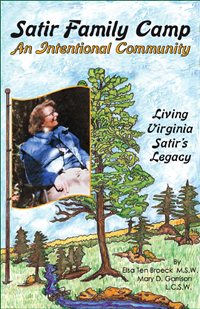 |
|
A new Book |
|
Doctor Stories
from the Island Journals of the Legendary “Dr. Koto”
DR. Kenjiro Setoue
Dr. Setoue was a successful surgeon in a large urban hospital who had tired of the long hours and was planning to start his own private practice. He agreed, in the interim, to take a job at a clinic on a small rugged island off the west coast of Kyushu. That was back in 1978. Dr. Setoue only intended to stay for six months, but he has been there ever since.
|
| A new Book |
Creative Connection for Groups Person-Centered Expressive Arts for Healing and Social Change
Natalie Rogers, Ph.D.
In the Creative Connection for Groups Dr. Natalie Rogers brings us a practical theoretical, and spiritual joining of the expressive arts and the person-centered approach for groups. Specific guidelines and explorations merge the values, purposes, and methods of both fields. Facilitators learn how to ap- ply this work in a wide variety of situations. The powerful images illustrate case material and the extraordinary effects of this profound group process.
Ultimately, this book is about courage, cre- ative expression, compassion, cooperation, and raising the collective consciousness to heal the planet. No small order. Yet the dy- namic, humanistic process of person-cen- tered expressive arts fosters in individuals and groups the ability to achieve this goal as they become authentic, self-actualized, and empowered. The forceful element of creative expression brings individuals personally and collectively into their strength, honing the ability to envision a brighter future and act across political or antagonistic boundaries to a more peaceful, all-inclusive way of being.
|
|
| A new Book |
|
The Viola in My Life
An Alto Rhapsody
Bernard Zaslav
During the 1950s and the early 1960s Bernard Zaslav played viola in Broadway shows like Fiddler on the Roof, Once Upon a Mattress, and the Broadway revival of Porgy and Bess, while commissioning and per- forming works written by the most innovative composers of the time, like Milton Babbitt, Charles Wuorinen, and Ben Johnston for string quartet and the viola/piano Zaslav Duo with Naomi Zaslav. He made the first recordings of Charles Ives Quartets and many of the Dvorak String Quartets before joining the world-famous Fine Arts String Quartet, and touring with them all around the world. His life as a string quartet violist reached a zenith when he joined the Vermeer Quartet, and became one of the world's most celebrated string quartet musicians.
Bernard Zaslav tells the story of his musical life and his travels from the perspective of a musician on the inside-literally, one of the inner voices of a string quartet. From the earliest days of his career he came into close musical and personal contact with iconic musicians, and he describes them and the musical world of the later 20th century with candid honesty, humility, and humor.
This book is a document not only about the life of a string quartet musician, but a document about the professional, social, and artistic musical life that flourished in America during the pre-digital age. It was a time when a string quartet in residence was a university's crowning glory, a time when the audience for classical music was at its most sophisticated and its most demanding, and a time when the creation and performance of a new piece of music was something to be celebrated. Included with the book are two CDs of excerpts from his many recordings.
|
Darling's journey involved the formation of the
Tarriers, with actor Alan Arkin, and creating the
massive hit “The Banana Boat Song,” making
the Tarriers the first group after the famous Weavers to
gain worldwide fame through the singing of folk
music, thus preparing the way for the Kingston Trio
and all who would follow. Having been inspired by
Pete Seeger and the original Weavers, life's typical
twists had him taking Seeger's place in that group.
Not finding the answers to his internal quest, however,
he found himself leaving the Weavers, forming the
Rooftop Singers and introducing the 12-string guitar
to popular music through their number one hit,
“Walk Right In.”
Darling's journey was a perilous one, as anyone's
journey in the arts is likely to be, given the twists of
fate that can affect the art world, along with the
confusion of becoming a political person, but not of
the left or the right. He ended up thinking that
our political answers lie in the realm of psychology,
and in the idea of (just as it sounds): a University for
Becoming More Fully Human.
Includes a CD with 24 songs. See track listing.
|
|
|
|
|
 |
A BOOK ABOUT THE INTENTIONAL COMMUNITIES OF VIRGINA SATIR
I believe Virginia created Satir Family Camp to provide a place where therapists could bring their families with them and learn experientially
about how families can optimally live,work, heal, and grow together.
—Russ Haber, from the foreword of Satir Family Camp
Visit
The Virginia
Satir Global Network
|
|
 |
|
